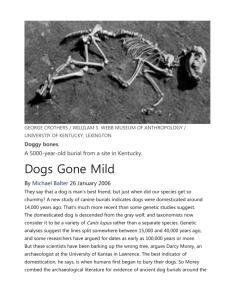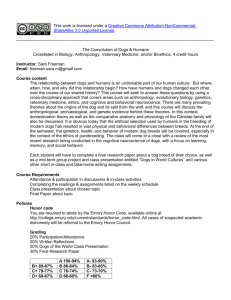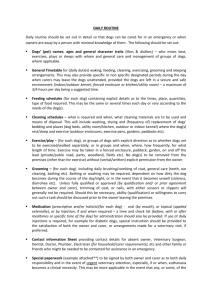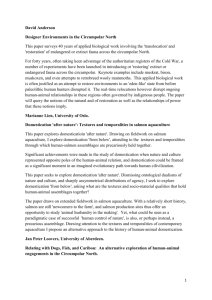Syllabus_LIF535_2014
advertisement
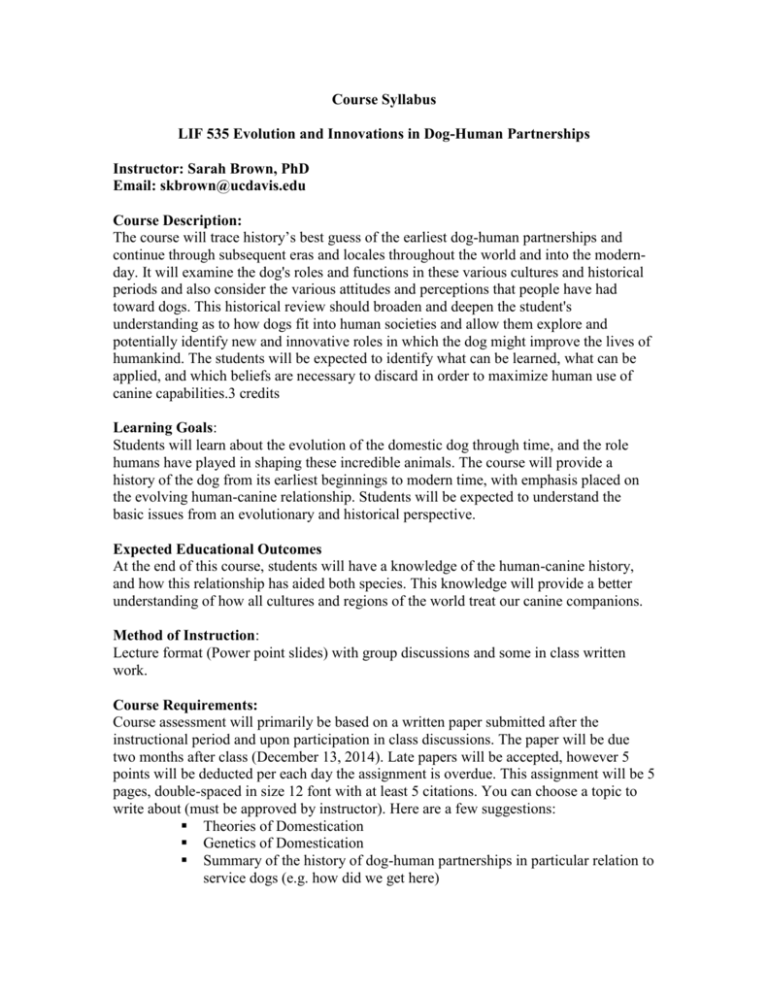
Course Syllabus LIF 535 Evolution and Innovations in Dog-Human Partnerships Instructor: Sarah Brown, PhD Email: skbrown@ucdavis.edu Course Description: The course will trace history’s best guess of the earliest dog-human partnerships and continue through subsequent eras and locales throughout the world and into the modernday. It will examine the dog's roles and functions in these various cultures and historical periods and also consider the various attitudes and perceptions that people have had toward dogs. This historical review should broaden and deepen the student's understanding as to how dogs fit into human societies and allow them explore and potentially identify new and innovative roles in which the dog might improve the lives of humankind. The students will be expected to identify what can be learned, what can be applied, and which beliefs are necessary to discard in order to maximize human use of canine capabilities.3 credits Learning Goals: Students will learn about the evolution of the domestic dog through time, and the role humans have played in shaping these incredible animals. The course will provide a history of the dog from its earliest beginnings to modern time, with emphasis placed on the evolving human-canine relationship. Students will be expected to understand the basic issues from an evolutionary and historical perspective. Expected Educational Outcomes At the end of this course, students will have a knowledge of the human-canine history, and how this relationship has aided both species. This knowledge will provide a better understanding of how all cultures and regions of the world treat our canine companions. Method of Instruction: Lecture format (Power point slides) with group discussions and some in class written work. Course Requirements: Course assessment will primarily be based on a written paper submitted after the instructional period and upon participation in class discussions. The paper will be due two months after class (December 13, 2014). Late papers will be accepted, however 5 points will be deducted per each day the assignment is overdue. This assignment will be 5 pages, double-spaced in size 12 font with at least 5 citations. You can choose a topic to write about (must be approved by instructor). Here are a few suggestions: Theories of Domestication Genetics of Domestication Summary of the history of dog-human partnerships in particular relation to service dogs (e.g. how did we get here) Themes discussed in class, (e.g. Dogs and Spirituality, Dogs in War) and how that relates to both service and modern dogs in general Suggested Reading: How the Dog Became the Dog: From Wolves to Our Best Friends Mark Derr Overlook-Duckworth 2011 ISBN: 978-1-59020-353-8 Required Reading: Larson et al. 2014. Current Perspectives and the future of domestication studies Dobney and Larson 2006. Genetics and Animal Domestication: New windows on an elusive process Wilkins et al. 2014. The “Domestication Syndrome” in Mammals: A unified explanation based on neural crest cell behavior and genetics Course Grading (see catalogue pg 37 or sample syllabus for grading A-F) The course will be graded as follows: A=Outstanding performance of the stated educational outcomes; B=Better than average performance of the stated educational outcomes; C=Average performance of the stated educational outcomes; D=Less than average performance of the stated educational outcomes F=Failed performance of the stated educational outcomes Sequence of Instruction: A. Monday October 13: Domestication of the Dog: 1. The origin of the dog: When, where, why and how? a. Archaeological and genetic data 2. Why wolves? a. Wolf behavior b. Human relationship with wolves 3. The roles of humans in the process a. Artificial vs. Natural selection 4. Comparison with other domesticates 5. DISCUSSION: (PDF sent to you) Larson et al. 2014. Current Perspectives and the future of domestication studies. B. Tuesday September 17: The Human-dog biological/social bond: 1. What makes a dog? a. Differences among dingoes and wolves b. Fox farm experiment 2. Behavioral studies 3. The role of Oxytocin 4. Effects of domestication a. Morphology b. Behavior DISCUSSION: Dobney and Larson 2006. Genetics and Animal Domestication: New windows on an elusive process Wilkins et al. 2014. The “Domestication Syndrome” in Mammals: A unified explanation based on neural crest cell behavior and genetics C. Wednesday September 18: Early human relationships with dog/proto-dog: 1. Burials 2. Hunting 3. Food 4. Guarding Dogs in Religion Consumption of Dog Meat Dogs and Culture: East Asia EVENING SESSION: Meet to discuss paper topics D. Thursday September 19: 1. Dogs and Culture: a. Europe b. Middle East c. Egypt d. North America E. Friday September 20: 1. Dogs in History a. Greeks and Romans b. Renaissance c. Victorian Era 2. Dogs of War F. Saturday September 21: 1. Modern Dogs 2. Re-cap of week
